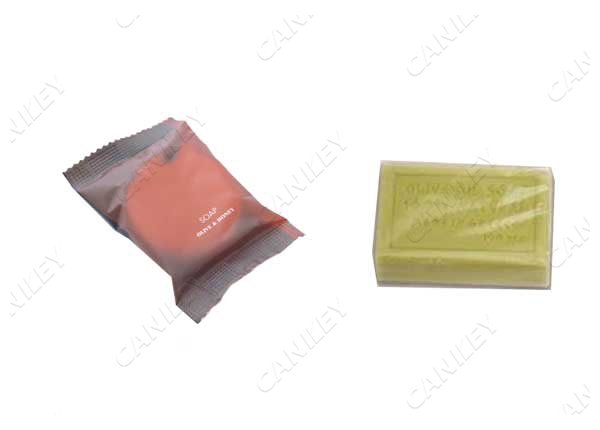What Are The Different Types of Soap Packaging?
- Release Lime: Oct 07 2023
- Source: Sherry
Soap is an essential part of our daily lives, providing cleanliness and comfort. While the quality and fragrance of the soap itself are crucial, the packaging plays a significant role in attracting consumers and preserving the product's integrity. But what are the different types of soap packaging?
Pillow type packaging
Pillow type packaging, often referred to as flow wrap packaging, is one of the most widely used methods to package soap bars. It involves wrapping the soap in a sealed, flexible plastic film that resembles a pillow. Here are some key characteristics and advantages of pillow type packaging:
A. Versatility: Pillow packaging can accommodate soap bars of various sizes and shapes. This flexibility makes it a preferred choice for manufacturers with diverse product lines.
B. Protection: The sealed plastic film provides excellent protection against moisture, dust, and external contaminants, ensuring that the soap remains fresh and hygienic until it reaches the consumer.
C. Visibility: Pillow packaging allows consumers to see the soap through the transparent film, which can be a significant selling point, especially when the soap has an attractive color, design, or texture.
D. Cost-effective: This packaging method is cost-effective due to its simplicity and efficiency in terms of material usage and production speed.

Cellophane wrapping
Cellophane wrapping is another classic choice for soap packaging. Cellophane is a thin, transparent material made from cellulose fibers. It has unique properties that make it suitable for wrapping soap:
A. Biodegradability: Cellophane is an eco-friendly option as it is biodegradable and compostable. This appeals to environmentally conscious consumers who seek sustainable products.
B. Protection: Cellophane provides a protective barrier against dust and minor moisture, ensuring that the soap retains its quality during storage and transit.
Soap packaging is not merely a functional necessity; it is an integral part of a product's identity. Pillow type packaging and cellophane wrapping are two common methods that cater to different consumer preferences and product requirements. Pillow packaging is versatile, cost-effective, and visually appealing, while cellophane wrapping offers an eco-friendly, elegant, and breathable option.
Manufacturers should carefully consider their target audience and the nature of their soap products when choosing the most suitable packaging method. Ultimately, the right packaging not only preserves the soap's quality but also enhances its marketability and consumer appeal. No matter which packaging method, you need professional soap packaging machine to complete the packaging process.
Pillow type packaging
Pillow type packaging, often referred to as flow wrap packaging, is one of the most widely used methods to package soap bars. It involves wrapping the soap in a sealed, flexible plastic film that resembles a pillow. Here are some key characteristics and advantages of pillow type packaging:
A. Versatility: Pillow packaging can accommodate soap bars of various sizes and shapes. This flexibility makes it a preferred choice for manufacturers with diverse product lines.
B. Protection: The sealed plastic film provides excellent protection against moisture, dust, and external contaminants, ensuring that the soap remains fresh and hygienic until it reaches the consumer.
C. Visibility: Pillow packaging allows consumers to see the soap through the transparent film, which can be a significant selling point, especially when the soap has an attractive color, design, or texture.
D. Cost-effective: This packaging method is cost-effective due to its simplicity and efficiency in terms of material usage and production speed.

Cellophane wrapping
Cellophane wrapping is another classic choice for soap packaging. Cellophane is a thin, transparent material made from cellulose fibers. It has unique properties that make it suitable for wrapping soap:
A. Biodegradability: Cellophane is an eco-friendly option as it is biodegradable and compostable. This appeals to environmentally conscious consumers who seek sustainable products.
B. Protection: Cellophane provides a protective barrier against dust and minor moisture, ensuring that the soap retains its quality during storage and transit.
Soap packaging is not merely a functional necessity; it is an integral part of a product's identity. Pillow type packaging and cellophane wrapping are two common methods that cater to different consumer preferences and product requirements. Pillow packaging is versatile, cost-effective, and visually appealing, while cellophane wrapping offers an eco-friendly, elegant, and breathable option.
Manufacturers should carefully consider their target audience and the nature of their soap products when choosing the most suitable packaging method. Ultimately, the right packaging not only preserves the soap's quality but also enhances its marketability and consumer appeal. No matter which packaging method, you need professional soap packaging machine to complete the packaging process.

 0086-15515573212
0086-15515573212 info@cankeytech.com
info@cankeytech.com



 Your Location:
Your Location: